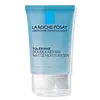What's inside
What's inside
 Key Ingredients
Key Ingredients

 Benefits
Benefits

 Concerns
Concerns

 Ingredients Side-by-side
Ingredients Side-by-side

Water
Skin ConditioningGlycerin
HumectantSilica
AbrasiveBetaine
HumectantNiacinamide
SmoothingCetearyl Isononanoate
EmollientZea Mays Starch
AbsorbentCeramide NP
Skin ConditioningCarbomer
Emulsion StabilisingGlyceryl Stearate Citrate
EmollientSodium Hyaluronate
HumectantSodium Hydroxide
BufferingPerlite
AbsorbentHydroxyacetophenone
AntioxidantCaprylyl Glycol
EmollientXanthan Gum
EmulsifyingWater
Skin ConditioningGlycerin
HumectantMethylpropanediol
SolventOctyldodecanol
EmollientCordyceps Sinensis Extract
AntioxidantTrametes Versicolor Extract
Vitis Vinifera Seed Oil
EmollientDicaprylyl Carbonate
EmollientButylene Glycol
HumectantXylitylglucoside
HumectantTocopheryl Acetate
AntioxidantPlukenetia Volubilis Seed Oil
EmollientRibes Nigrum Seed Oil
EmollientPueraria Lobata Root Extract
HumectantPunica Granatum Fruit Extract
AntioxidantSisymbrium Irio Seed Oil
MaskingHelianthus Annuus Seed Oil Unsaponifiables
EmollientCardiospermum Halicacabum Flower/Leaf/Vine Extract
Skin ConditioningRosmarinus Officinalis Leaf Extract
AntimicrobialGlycine Soja Oil
EmollientAnhydroxylitol
HumectantXylitol
HumectantSerine
MaskingSodium Hyaluronate
HumectantCitric Acid
BufferingTocopherol
AntioxidantAlgin
MaskingGlyceryl Polyacrylate
Pullulan
Trehalose
HumectantPentylene Glycol
Skin ConditioningSorbitan Isostearate
EmulsifyingAmmonium Acryloyldimethyltaurate/Vp Copolymer
Hydroxyethyl Acrylate/Sodium Acryloyldimethyl Taurate Copolymer
Emulsion StabilisingUrea
BufferingIsohexadecane
EmollientPolysorbate 60
EmulsifyingDisodium Phosphate
BufferingPotassium Phosphate
BufferingCaprylyl Glycol
EmollientSodium Citrate
BufferingPhenylpropanol
MaskingPotassium Sorbate
PreservativeSodium Benzoate
MaskingWater, Glycerin, Methylpropanediol, Octyldodecanol, Cordyceps Sinensis Extract, Trametes Versicolor Extract, Vitis Vinifera Seed Oil, Dicaprylyl Carbonate, Butylene Glycol, Xylitylglucoside, Tocopheryl Acetate, Plukenetia Volubilis Seed Oil, Ribes Nigrum Seed Oil, Pueraria Lobata Root Extract, Punica Granatum Fruit Extract, Sisymbrium Irio Seed Oil, Helianthus Annuus Seed Oil Unsaponifiables, Cardiospermum Halicacabum Flower/Leaf/Vine Extract, Rosmarinus Officinalis Leaf Extract, Glycine Soja Oil, Anhydroxylitol, Xylitol, Serine, Sodium Hyaluronate, Citric Acid, Tocopherol, Algin, Glyceryl Polyacrylate, Pullulan, Trehalose, Pentylene Glycol, Sorbitan Isostearate, Ammonium Acryloyldimethyltaurate/Vp Copolymer, Hydroxyethyl Acrylate/Sodium Acryloyldimethyl Taurate Copolymer, Urea, Isohexadecane, Polysorbate 60, Disodium Phosphate, Potassium Phosphate, Caprylyl Glycol, Sodium Citrate, Phenylpropanol, Potassium Sorbate, Sodium Benzoate
 Reviews
Reviews

Ingredients Explained
These ingredients are found in both products.
Ingredients higher up in an ingredient list are typically present in a larger amount.
Caprylyl Glycol is a humectant and emollient, meaning it attracts and preserves moisture.
It is a common ingredient in many products, especially those designed to hydrate skin. The primary benefits are retaining moisture, skin softening, and promoting a healthy skin barrier.
Though Caprylyl Glycol is an alcohol derived from fatty acids, it is not the kind that can dry out skin.
This ingredient is also used as a preservative to extend the life of products. It has slight antimicrobial properties.
Learn more about Caprylyl GlycolGlycerin is already naturally found in your skin. It helps moisturize and protect your skin.
A study from 2016 found glycerin to be more effective as a humectant than AHAs and hyaluronic acid.
As a humectant, it helps the skin stay hydrated by pulling moisture to your skin. The low molecular weight of glycerin allows it to pull moisture into the deeper layers of your skin.
Hydrated skin improves your skin barrier; Your skin barrier helps protect against irritants and bacteria.
Glycerin has also been found to have antimicrobial and antiviral properties. Due to these properties, glycerin is often used in wound and burn treatments.
In cosmetics, glycerin is usually derived from plants such as soybean or palm. However, it can also be sourced from animals, such as tallow or animal fat.
This ingredient is organic, colorless, odorless, and non-toxic.
Glycerin is the name for this ingredient in American English. British English uses Glycerol/Glycerine.
Learn more about GlycerinSodium Hyaluronate is hyaluronic acid's salt form. It is commonly derived from the sodium salt of hyaluronic acid.
Like hyaluronic acid, it is great at holding water and acts as a humectant. This makes it a great skin hydrating ingredient.
Sodium Hyaluronate is naturally occurring in our bodies and is mostly found in eye fluid and joints.
These are some other common types of Hyaluronic Acid:
Learn more about Sodium HyaluronateWater. It's the most common cosmetic ingredient of all. You'll usually see it at the top of ingredient lists, meaning that it makes up the largest part of the product.
So why is it so popular? Water most often acts as a solvent - this means that it helps dissolve other ingredients into the formulation.
You'll also recognize water as that liquid we all need to stay alive. If you see this, drink a glass of water. Stay hydrated!
Learn more about Water